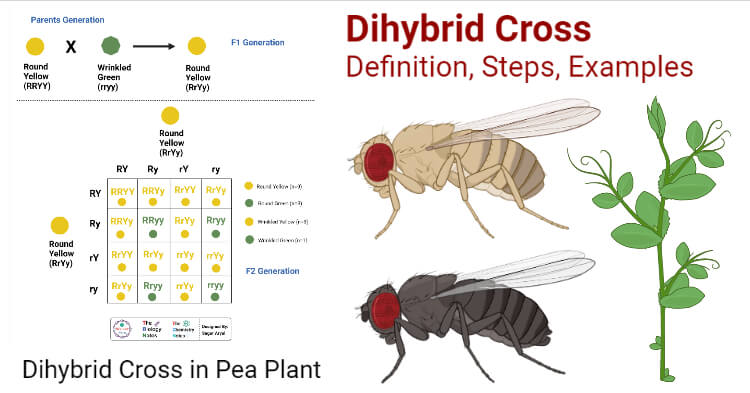How To Set Up A Dihybrid Cross
Dihybrid Cross Definition
A dihybrid cross is a type of genetic cross between two individuals with either homozygous or heterozygous genotypes of two characters or traits.
- The dihybrid cross is different from the monohybrid cantankerous, which but involves a unmarried genetic grapheme or trait.
- Dihybrid crosses are more complex than monohybrid crosses as these involve more than one genetic trait where the parents can be either homozygous or heterozygous for these traits.
- The dihybrid cross is used as a method to make up one's mind or bear witness the police force of independent assortment as information technology proves that 2 characters segregate independently of one another. However, it only works in the instance of genes that are not linked and are present on unlike chromosomes.
- The number of gametes formed during a dihybrid cantankerous is more than than those during a monohybrid cross, as two split up genes are involved in the case of a dihybrid cross.
- The number of offsprings is also more in the example of a dihybrid cross. These accept a more phenotypic variation than the ones obtained from monohybrid crosses.
- The phenotypic ratio of the offsprings in the get-go generation afterward a dihybrid cross is written every bit ix:iii:three:1. The genotypes of the offsprings are even more diverse with the ratio of 1:ii:ii:4:1:2:1:two:i.

Steps/Procedure
The following are the steps to be followed in club to conduct a dihybrid cross between ii individuals;
i. Selection of parents
- The outset step in the dihybrid cross is the selection of characters equally well as parents that are to be crossed.
- The pure lines are obtained by selfing the individuals for three generations which confirms the presence of pure lines.
ii. Designation for the characters
- The alleles for the 2 characters selected are designated with certain alphabet characters. The dominant alleles are indicated past upper case messages, whereas the recessive alleles are indicated with lower case letters.
three. Punnet square
- Since gametes are to be formed for fertilization, the gametes are formed. Four distinct gametes are formed while studying the two characters.
- The Punnet square is fix up by listing the phenotype and genotype of the parents. The gametes will be haploid equally a result of meiotic partition.
- The possible combinations of the genotypes are filled into the Punnet square, and all combinations are equally possible as the process of fertilization is random.
iv. Decision of ratios
- Once all the combinations are determined, the phenotypic and genotypic ratios of the offsprings are adamant noted down.
Examples of Dihybrid Cross
1. Dihybrid cantankerous in Pea plants
- An example of a dihybrid cross is the cross between a homozygous pea plant with circular yellow seeds and wrinkled greenish seeds.
- The round xanthous seeds are represented by RRYY alleles, whereas the wrinkled green seeds are represented by rryy. The gametes formed from these alleles are RY and ry.
- When the two parents are crossed, the F1 hybrids with the RrYy allele are formed. The hybrids contain round yellow seeds (RrYy) with the ascendant R allele for roundness and the dominant Y allele for the yellow colour.
- The iv alleles can combine in four different combinations; RY, Ry, rY, and ry. the four alleles are assorted randomly to produce four types of gametes.
- The gametes unit at random during fertilization to produce xvi types of individuals in the F2 generation.
- The hybrids occur in the ratio of 9 round yellow, iii round green, 3 wrinkled yellow, and 1 wrinkled green.

two. Dihybrid cross in Drosophila
- Another instance of a dihybrid cross can exist observed in the case of homozygous long-winged and black-bodied Drosophila and vestigial-winged and grey-bodied fly.
- The F1 generation hybrids obtained are long-winged grey-bodied Drosophila fly. The hybrids, later on mating with each other to produce the F2 generation.
- The F2 generation includes 9 long-winged grey bodies, 3 long-winged black-bodied, 3 vestigial-winged gray-bodied, and 1 vestigial winged black-bodied Drosophila .
References and Sources
- Verma PS and Agarwal VK (3005). Prison cell Biology, Genetics, Molecular Biology, Development, and Ecology. Multicolored Edition.
- https://geneticsstudy.blogspot.com/2009/08/punnetts-gametic-checkerboard-method.html – ix%
- https://thefactfactor.com/facts/pure_science/biology/genetics/mendels-dihybrid-cross-experiment/10026/ – 5%
- https://pediaa.com/deviation-between-monohybrid-cross-and-dihybrid-cross/ – 5%
- https://www.thoughtco.com/dihybrid-cross-a-genetics-definition-373463 – iv%
- https://microbenotes.com/monohybrid-cross/ – 4%
- https://www.thoughtco.com/contained-assortment-373514 – ii%
Source: https://thebiologynotes.com/dihybrid-cross/

0 Response to "How To Set Up A Dihybrid Cross"
Post a Comment